Have you ever wondered why some guitars feel like a dream to play while others feel like a struggle? The answer lies in the concept of “playability.” So, why are some guitars easier to play?
Understanding these principles can help you make better choices when buying a guitar and improve your playing experience. Keep on reading to learn more.
You can use the table of contents below to take you to the area that interests you. Click on the little box to open it, and then click on the section of the article you want to read, or you can read from start to finish if you want the full learning experience!
The Short Answer
The playability of a guitar, or why some guitars are easier to play, is influenced by several factors. These include the guitar’s action, neck width and profile, fret size, setup, and the type of strings used. Additionally, the design and construction of the guitar, such as the body shape and the type of wood used, can also impact playability.
Keep On Reading (Below) To Learn More
Understanding Guitar Playability
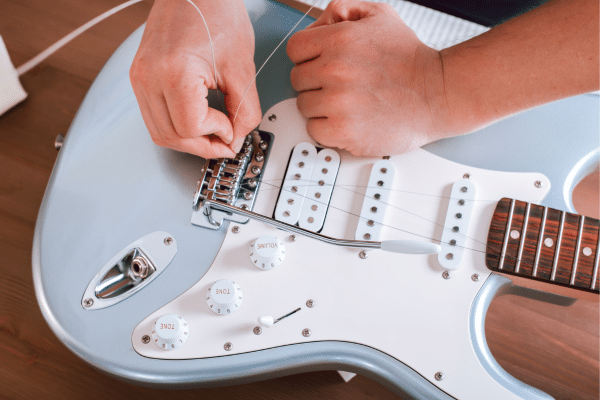
Playability refers to how comfortable and easy a guitar is to play.
You’re probably reading this article because you’ve played several guitars and noticed that some play great, others not so much, and a few are a total nightmare! Or, perhaps you are thinking about taking up the guitar and want to understand what makes a guitar sound and play great.
The cost of a guitar doesn’t always determine how playable it will be. If only it were that easy! I’ve played guitars that sell for under $200 that play better than significantly more expensive ones.
What we can say is that a guitar’s design, construction, and setup can all affect the way it will play, and this is what we’ll be looking at in this article.
The Impact Of Guitar Design And Construction
The design and construction of a guitar can play a role in its playability. For example, electric guitars with a cutaway design are easier to play higher up on the neck, and the type of wood used can also affect the weight of the guitar, which can impact playability.
Let’s have a closer look at some of the specifics.
Acoustic Versus Electric
Let’s begin here because you most likely all ready have or are thinking of getting an acoustic or electric guitar. It’s one of the first decisions that new players make.
It’s just a fact that acoustics are generally more difficult to play than electrics for a number of reasons.
Here’s a comparison table that outlines things that can affect the playability of acoustic guitars versus electric guitars.
| Factors | Acoustic Guitars | Electric Guitars |
|---|---|---|
| Action | Typically higher, requiring more finger strength to press down strings. | Typically lower, making it easier to press down strings. |
| Neck Width and Profile | Generally wider, which can be more comfortable for complex chords but may be harder for smaller hands. | Generally narrower, which can be easier for soloing and for players with smaller hands. |
| Fret Size | Often smaller, requiring more precision when pressing down strings. | Often larger, making it easier to press down strings, but can cause intonation issues if pressed too hard. |
| Guitar Setup | Requires regular setup for optimal playability, but less likely to need adjustments due to fewer components. | Requires regular setup and may need more frequent adjustments due to more components like pickups and electronics. |
| Strings | Generally uses heavier gauge strings, which provide a fuller tone but require more finger strength. | Generally uses lighter gauge strings, which are easier to press down and bend with fingers. |
| Design and Construction | No cutaway design in traditional models, making it harder to access higher frets. | Often includes a cutaway design, making it easier to access higher frets. |
| Weight | Typically lighter, due to hollow body and thinner wood. | Generally heavier, due to solid or semi-hollow body construction. |
Just so you know, these are general observations, and there can be exceptions based on specific models and personal preferences.
Food For Thought
Did that change your thinking about what type of guitar you should get? Sometimes, it’s better to get the kind of guitar you need to play the music you like. So, for example, if you’re an all-acoustic player, you shouldn’t be looking at electric guitars designed to play Metal because they play like a dream!
On the other hand, some beginning players want to start on an electric, which is much easier on fingers that don’t have callouses or fretting dexterity, and get an acoustic guitar after they’ve been playing for a while. That’s ok, too. Do whatever works best for you!
Neck Width And Profile
The neck’s width and profile significantly impact a guitar’s playability. I’m more of a narrow-neck player because I find it more comfortable as I move higher up the neck.
The neck profile, or the shape of the back of the neck, also plays a role. Profiles can range from the thin and flat ‘C’ shape to the thicker ‘U’ shape. I tend to like a ‘C’ or ‘V’-shaped neck in an electric guitar and a ‘D’-shaped neck in an acoustic.
Fretboard Radius
The fretboard radius of a guitar refers to the curvature of the fretboard across its width, and it can significantly affect the playability of a guitar.
Fretboards with a smaller radius (like 7.25″) are more curved or “round,” which can make them more comfortable for chord playing. However, a rounder fretboard can cause the strings to “choke out” or lose sustain when bent, especially if the action is low, as the string can come into contact with a higher fret.
Fretboards with a larger radius (like 12″ or 16″) are flatter, which can make them more comfortable for single-note playing and string bending across the fretboard. This is why flatter fretboards are often preferred for lead guitar playing and genres like rock and metal.
Some guitars feature a compound radius fretboard, which combines the best of both worlds. The fretboard is more rounded at the nut (for comfortable chord playing) and gradually becomes flatter towards the body (for easier lead playing and string bending). This design aims to provide a balance of comfort and versatility.
Nut Spacing
If the string grooves in the nut are spaced wider apart, there’s more room between the strings. This can be beneficial for intricate fingerpicking styles, as it gives your fingers more room to pluck individual strings. It can also be helpful for players with larger fingers, as it reduces the chance of accidentally muting adjacent strings.
On the other hand, narrower nut spacing means the strings are closer together. This can make it easier to form chords, especially for players with smaller hands or shorter fingers, as it reduces the stretch between strings.
Fret Size
Frets come in various sizes, and the size can influence playability. Larger frets allow you to bend the strings and do finger vibrato easier, especially with a lower action, making the guitar easier to play. However, they might cause intonation issues if you press too hard because you will be bending the note sharp.
Fret Number
Acoustic guitars usually have 20 frets, although they can have 18 or 19. Electric guitars have more and can vary at 21, 22, or even 24 frets (two octaves).
Guitars with fewer frets typically have a shorter neck, making them easier to play. On the other hand, guitars with more frets usually have a longer neck, allowing for greater range.
However, you won’t really notice the difference between a 21 and a 22-fret guitar.
Neck Scale Length
The scale length of a guitar, which is the distance from the nut to the bridge, significantly affects the guitar’s playability.
A longer scale length increases the distance between the frets, which can make it harder to reach certain chords or notes, especially for players with smaller hands. A longer scale length also increases string tension, which can result in a brighter tone and better intonation, but make it more difficult to bend notes or do finger vibrato.
Body Size
The size of a guitar’s body can significantly impact its playability, particularly in terms of comfort. Larger body sizes, such as those found on jumbo or dreadnought acoustic guitars, can produce a loud and full sound, but they might be uncomfortable for some players to hold, especially for extended periods.
Some electric guitars with thick bodies, like a Les Paul, can be particularly heavy to play standing up for extended periods.
Body Shape
The shape of a guitar’s body also plays a significant role in its playability. For example, guitars with a single or double cutaway design offer easier access to the higher frets, making them more playable for lead guitarists or those who frequently play in the instrument’s upper register.
Some body shapes, like a Stratocaster, are designed with contours and curves that fit comfortably against the player’s body, enhancing playability.
Guitar Setup Is Critical!
A proper guitar setup is crucial for optimal playability. A well-set-up guitar will be easier to play and sound better.
Here’s a table that outlines how various aspects of a guitar’s setup can affect its playability:
| Factors | Effect on Playability |
|---|---|
| Type and Gauge of Guitar Strings | Lighter gauge strings and certain types of strings (like nylon) are easier to press down and bend, making the guitar easier to play. |
| Action | Lower neck action makes the strings easier to press down, improving playability for fast passages or complex chords. |
| Truss Rod Adjustment | Proper truss rod adjustment ensures the right amount of relief in the neck, affecting the action and, thus, the playability. |
| Pickup Height | Pickups too close to the strings can increase the magnetic pull, making the strings harder to bend or do finger vibrato. |
| Bridge and Saddle Adjustments | Bridge and saddle adjustments can affect the action and, thus, the playability. |
Just so you know, these are general observations, and there can be exceptions based on specific models and personal preferences.
Type And Gauge Of Guitar Strings
The type of strings you use can significantly affect playability.
There are several types of guitar strings, including steel, nickel, bronze, and nylon, among others. The type of string used can affect the tone and playability of the guitar. For example, nylon strings, often used on classical guitars, are softer and easier on the fingers than steel strings, making them a popular choice for beginners. However, they produce a different tone than steel strings and are typically used for different styles of music.
The gauge of a guitar string refers to its thickness. String gauges are usually categorized as light, medium, or heavy. Lighter gauge strings are thinner, require less tension to be tuned to the correct pitch, and are generally easier to press down and bend. This can make them a good choice for beginners, players with less finger strength, or styles of music that require a lot of string bending and vibrato, such as blues or rock.
However, heavier gauge strings often produce a fuller and louder tone and can provide better sustain. They’re often preferred by players who strum hard or play styles of music that require a robust tone, such as heavy rock or metal.
Action
The action of a guitar, or the distance between the strings and the fretboard, significantly affects its playability.
The strings are closer to the fretboard when a guitar has low action. This makes pressing the strings down to the frets easier, requiring less finger strength and reducing finger fatigue. It can make fast passages and complex chords easier to play, so many lead guitarists and shredders prefer a low action.
However, if the action is too low, it can cause problems such as fret buzz, which occurs when a string vibrates against one or more of the frets. This is because there isn’t enough space for the string to vibrate freely. Extremely low action can also result in poor sustain and a loss of tonal quality.
Truss Rod Adjustment
The truss rod is a metal rod inside the guitar neck that counteracts the tension from the strings. Adjusting the truss rod changes the neck’s curvature, affecting the action and the guitar’s overall playability.
So, the truss rod plays a crucial role in a guitar’s playability by allowing adjustments to the neck relief and, consequently, the action. The optimal truss rod adjustment depends on the player’s personal preference, playing style, and the specific guitar and strings used. It’s often a balance between ease of play, avoiding fret buzz, and achieving the desired tone.
Pickup Height
The height of the electric guitar pickups mainly influences the tone and volume of the guitar.
However, if the pickups are too close to the strings, the magnetic pull on them can make the strings harder to bend or do finger vibrato.
Pickups that are too close to the strings can also affect the guitar’s intonation and sound quality. You should always adjust the pickup height to its “sweet spot,” which gives the best tone with good intonation.
Bridge And Saddle Adjustments
The bridge and saddles play a role in determining a guitar’s playability by changing the action of the guitar neck.
A lower action makes the strings easier to press down, which can make the guitar easier to play, especially for beginners or for complex chords and fast passages. However, if the action is too low, it can cause fret buzz.
The bridge saddles can also be adjusted to correct intonation issues.
Electric Guitars That Are Easy To Play

I often recommend these electric guitars for their playability, listed alphabetically.
I left you a link to click to learn more about each guitar and check out some of the reviews. You don’t have to buy anything, just have fun with it! Lol ?
Remember, the “ease” of how a guitar plays can be subjective and depends on a player’s personal preferences, hand size, and playing style. It’s always a good idea to try out a guitar in person before buying, if possible.
Fender American Professional II Stratocaster

Click HERE To Check Reviews & Price On Amazon
Known for its comfortable “Deep C” neck profile and narrow-tall frets, which make bending notes easier. The Stratocaster also has a contoured body for comfortable playing.
I’ve played Strats forever, and they feel super comfortable and play great when set up right!
Fender American Professional II Telecaster

Click HERE To Check Reviews & Price On Amazon
Like the Stratocaster, the Telecaster features a comfortable “Deep C” neck profile and narrow-tall frets. Its simple design and smooth playability make it a favorite among many guitarists.
Teles have a more “compact” feel than a Strat.
Gibson SG Standard

Click HERE To Check Reviews & Price On Guitar Center
The Gibson SG Standard is known for its slim taper neck and lightweight body, making it comfortable to play for extended periods. The double cutaway design allows for easy access to the upper frets, and the lower string tension due to the shorter scale length makes bending notes easier than many Fender guitars.
This is definitely one of my favorite guitars. The deep cutaways make upper fret access a breeze, and it plays lightning fast!
Ibanez RG Series

Click HERE To Check Reviews & Price On Amazon
Ibanez guitars are renowned for their thin, flat necks and wide fretboards, making them particularly suitable for fast playing and complex chord shapes. The RG series is a favorite among rock and metal guitarists.
You can’t go wrong with an Ibanez RG guitar. I have several, and they will take your playing to another level as you begin to master technical wizardry! You’re looking at the complete package; great neck, pickups, bridge, and looks!
PRS SE Custom 24

Click HERE To Check Reviews & Price On Amazon
This guitar has a wide-thin neck shape that’s comfortable for both chord playing and soloing. It also features a double cutaway body design for easy access to the higher frets.
I have five PRS guitars, one signed by Paul Reed Smith. If you’re looking for exceptional tone and playability, check out the SE models, which won’t break the bank!
Yamaha Pacifica Series

Click HERE To Check Reviews & Price On Amazon
Yamaha Pacifica guitars are known for their comfortable necks and contoured bodies. They also have a double cutaway design for easy access to the upper frets.
These are great guitars to start on, and they can take you all the way to a gigging pro!
My Personal Pick
If I had to choose just one from the list, I would go with the Gibson SG Standard. It’s a Rock N’ Roll machine but sounds great with any type of music!
I have a friend that uses an SG guitar to make a living playing broadway show tunes.
Acoustic Guitars That Play Easy
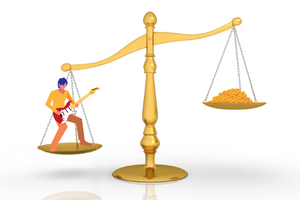
I often recommend these acoustic guitars for their playability, listed alphabetically.
I left you a link to click to learn more about each guitar and check out some of the reviews. You don’t have to buy anything, just have fun with it! Lol ?
Remember, the “ease” of how a guitar plays can be subjective and depends on a player’s personal preferences, hand size, and playing style. It’s always a good idea to try out a guitar in person before buying, if possible.
Epiphone Songmaker DR-100
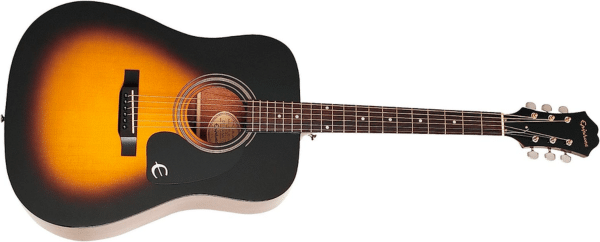
Click HERE To Check Reviews & Price On Amazon
This guitar is known for its slim taper neck, making it comfortable for most hand sizes. It’s a great value for beginners.
Epiphone guitars give you a lot of bang for the buck and are made by Gibson. You won’t find a better guitar for under $200!
Fender American Acoustasonic Telecaster
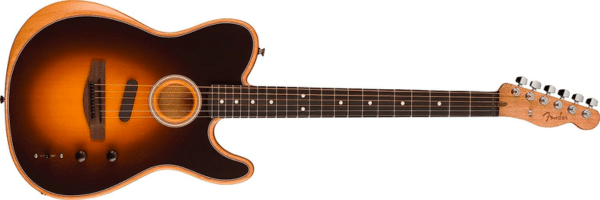
Click HERE To Check Reviews & Price On Amazon
This innovative guitar features a comfortable “Deep C” neck profile and a contoured body for comfortable playing. Its unique design also allows for a wide range of electric and acoustic tones.
This guitar is versatile enough to take you from Folk to Rock! It’s also an excellent choice for acoustic beginners because it plays so easily!
Martin LX1E Little Martin
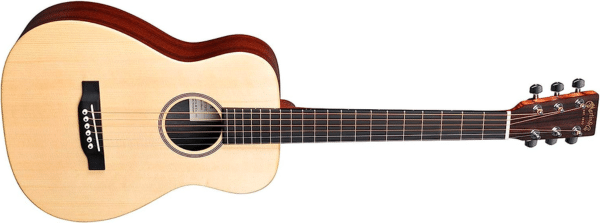
Click HERE To Check Reviews & Price On Amazon
Despite its smaller size, this guitar is known for its comfortable playability and rich tone. It’s great for younger players or those with smaller hands.
Nothing sounds and plays like a Martin! It’s the smallest guitar Martin makes, so if you’re looking for that “parlor” guitar vibe, check this baby out!
Seagull S6 Original
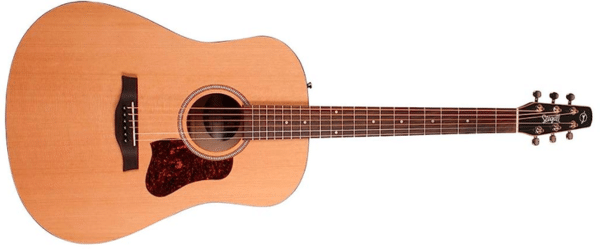
Click HERE To Check Reviews & Price On Amazon
The Seagull S6 features a wider neck that’s great for fingerpicking styles. It’s also known for its solid construction and rich tone.
This guitar is a great choice if you’re looking for that big dreadnought sound! You’d be surprised how well it can fill a large room without a microphone or going into a mixing board.
Taylor GS Mini
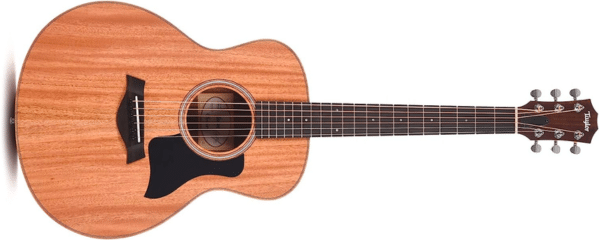
Click HERE To Check Reviews & Price On Amazon
This smaller-sized guitar is known for its comfortable playability, making it great for younger players or those with smaller hands. Despite its size, it has a full and rich tone.
If you like the sound of a mahogany top acoustic, you should give this guitar a look! It also has an ebony fingerboard that plays great. Taylor guitars have their own unique sound and are played by virtually all the big-name acts.
Yamaha FG800
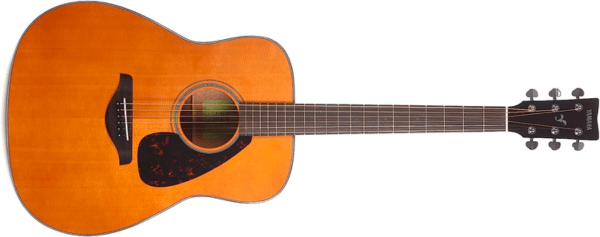
Click HERE To Check Reviews & Price On Amazon
This guitar is known for its comfortable neck and excellent playability. It’s a great value and suitable for beginners and intermediate players.
It has a tone with a tighter low-end than most other guitars in the dreadnaught category. It’s also pretty lightweight for its size.
My Personal Pick
For my money, I’d go with the Fender American Acoustasonic Telecaster. I like it a little better than the Acoustasonic Stratocaster because I think it has a richer tone. I love acoustics that play like electrics!
You could make this your first guitar purchase and cover tons of acoustic and electric tunes without bringing a second instrument to the gig, assuming you’re not a heavy-duty rocker or metal player.
Playability Is A Relative Term

“Playability” is a relative term, to a certain extent. A guitar that plays great for you may not be ideal for another player. Some guitars will just not be your cup of tea, while others may simply need to be adjusted appropriately for your playing style and musical genre.
It’s unusual to find a guitar that plays and sounds perfectly right out of the case.
So, it’s a good idea to play a variety of guitars to get an idea of what you’re looking for. Do you like a guitar with a thin neck and a flat fretboard radius, or do you prefer a chunkier neck with vintage-size frets, etc.?
Are You Qualified To Make Guitar Adjustments Or Modifications?
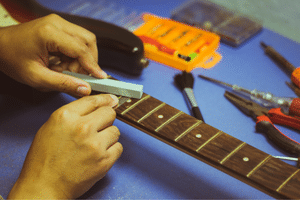
It’s great to work on your guitars, especially if you have a lot of them, but you should always be aware of your limitations.
Adjusting things like an electric guitar’s string height (action) or pickup height can be straightforward. Still, some adjustments require the proper training and experience, like adjusting a guitar’s truss rod.
When you doubt your ability to adjust, repair, or modify your guitar, it’s always best to bring it to a competent guitar technician or luthier (guitar designer & builder). You can permanently damage your guitar, and it might never play and sound right again!
Making modifications to your guitar can void its manufacturer’s warranty and cause permanent damage to the instrument. Certain modifications are irreversible, so you may be stuck with them, even if you desperately want to restore the guitar to its original condition!
I learned that the hard way over the years until I did a three-year apprenticeship in a guitar repair shop. Now I have my own home workshop with the proper training and equipment to safely maintain and repair all my instruments.
Remember: “When In Doubt, Send It Out!”
Frequently Asked Questions

Here are some of the questions I get asked about guitars.
If your question does not appear here, please put it in the comments, and I will get right back to you with an answer.
How Often Should I Have My Guitar Set Up For Optimal Playability?
Getting your guitar professionally set up at least once a year is recommended. However, if you notice any issues with playability, you should get it checked sooner.
Why Does A Guitar Sound Better The More You Play It?
As you break in a guitar, playing can become more comfortable due to the flattening of rough edges on the neck, etc. Also, tonewoods begin to become more resonant as they age.
What Makes A Guitar Louder?
Things that make a guitar louder are design and construction, wood quality, pickups, string type and gauge, and the amplifier you plug it into.
Playing style and guitar pick design also come into play. Guitarists with a very aggressive picking style can make a guitar sound louder.
Due to increased wood resonance, some guitars, especially acoustic instruments, can get louder as they age.
Are Older Guitars Better Than Newer Ones?
Yes, sometimes, but not always. A high-quality and well-made guitar can sound better than a newer one as it ages if it is taken care of and stored correctly. This is because as the wood ages, it vibrates better.
However, some electromagnetic pickups can lose power as they age. This may be preferable on a Jazz guitar because the sound becomes richer and more mellow. Aged pickups may not work well on a Metal guitar, which requires an aggressive sound.
Do More Expensive Guitars Sound Better?
Generally speaking, more expensive guitars sound better because they are made better than cheaper ones. Higher-end guitars can have things like better tonewoods, pickups, and hardware.
However, a proper guitar setup can make any instrument sound and play better.
Do Bigger Guitars Sound Better?
It depends on the sound you want.
Larger-body guitars tend to have a more robust low end and midrange, while smaller guitars have more prominent high frequencies. This is especially true with acoustic guitars.
Electric solid-body guitars that are thicker can have a more balanced sound and more natural sustain.
Final Thoughts

In our exploration of “Why Are Some Guitars Easier To Play,” we’ve delved into the many factors contributing to playability. I hope this article has provided valuable insights to help you make informed decisions when choosing a guitar.
The physical attributes of a guitar, including its action, neck width and profile, fret size, and overall design and construction, play significant roles in determining its playability. Similarly, the number of frets and the scale length can affect the range of notes and the tension of the strings, further influencing how a guitar feels to play.
The size and shape of a guitar’s body and the spacing of the grooves in the nut contribute to the overall comfort and ease of playing. The type and gauge of strings, the action, and the truss rod adjustment are also critical factors that can significantly affect a guitar’s playability.
Furthermore, properly adjusting the bridge and saddle is crucial for ensuring correct intonation and comfortable action, both of which significantly affect a guitar’s playability.
However, it’s important to remember that these factors are not absolute. The optimal setup can vary greatly depending on the player’s preferences and playing style.
The best guitar for you is the one that feels comfortable in your hands, sounds great, and inspires you to play. It’s about finding the right balance of all these factors to suit your individual needs and preferences. Happy playing!

Here’s a great video from Fender, where Dr. Molly Miller explains the primary differences in sound and playability between acoustic and electric guitars. Enjoy!
Related Article ➡ Is It Easier To Play More Expensive Guitars? Find Out Now!
Related Article ➡ Are Cheap Electric Guitars Harder To Play? Let’s Find Out!
What To Read Next ➡ How Many Guitars Do You Really Need? – Check This Out!
Related Article ➡ Expensive Guitar Vs Expensive Amp: The Essential Guide!
Tell Me What You Think

Please leave a comment below if you enjoyed this article, have any questions about guitars, or want to give your point of view. I will be happy to help you.
- If you could buy only one guitar, would it be acoustic or electric? Why?
- What are the primary features you look for in playability when you buy a guitar?
- How do you like to set up your guitars to make them more playable?
- What else is on your mind?



Great blog and very informative. Thank you ??
Thank You, Jonathan!
I really appreciate that!
Rock On! ?
Frank ?
Hi Frank, I really love your website and your article is nicely broken down. This is a subject that has bothered me for many years and that I never thought that there could be a clear answer to, so thank you! It is so true that the price of the instrument has absolutely nothing to do with its playability! I started out as a teenager on an ‘Eco’ Italian made acoustic guitar with steel strings, it was huge and it was the only way I knew a guitar to be. I was blown away when I got my first slimline electric guitar later in life. I still feel that the acoustic has far more beautiful sound, especially for particular melodies, but the electric is so much easier to play well on for me, as far as riffs etc. go. As you wrote, it also depends on the type of music you want to play on the guitar, Spanish folk vs heavy rock… I am especially enlightened to have read about the ‘action’, this is something I was completely unaware of till now and shall keep this in mind. Thanks, finally, for the recommendations. Very helpful.
Hi, Michelle
I appreciate your comments!
Yes, although electric guitars are easier to play and offer many more tonal options, acoustic guitars have a very natural and beautiful sound.
Ideally, owning one of each is a great idea if you play electric and acoustic music.
Some solid-body electrics come with piezoelectric pickups, which give a nice approximation of an acoustic sound so you can have the best of both worlds. 😎
Rock On! 🤘
Frank 🎸
Wow, this article is incredibly informative! As a beginner, I’m trying to figure out which guitar would be the best fit for me. I’m leaning towards an electric guitar because it seems like they’re generally easier to play, especially for someone like me who doesn’t have a lot of finger strength yet.
The Ibanez RG Series caught my eye because of its thin, flat neck and wide fretboard, which the article says is suitable for fast playing and complex chord shapes. Plus, it’s a favorite among rock and metal guitarists, and I’m a big fan of those genres.
On the other hand, the Yamaha Pacifica Series also seems like a good option. It’s known for its comfortable neck and contoured body, and it’s said to be a great guitar to start on.
I guess I’ll have to try them out in person to see which one feels the best. The article made a great point about how playability is a relative term and that what works for one person might not work for another.
I’m also going to keep in mind that the setup of the guitar is critical. So, once I decide on a guitar, I’ll make sure to get it professionally set up for optimal playability.
Overall, this article has given me a lot to think about. It’s clear that there’s more to choosing a guitar than just picking one that looks cool. I’m excited to start my guitar journey!
Hi, Constanza
Thank You for your Comments!
I think starting with an electric guitar, as a beginning player, is a great approach! You can’t go wrong with either the Ibanez RG or the Yamaha Pacifica series.
When you purchase your guitar, ask the seller to throw in a free setup.
Best of Luck! 😎
Rock On! 🤘
Frank 🎸